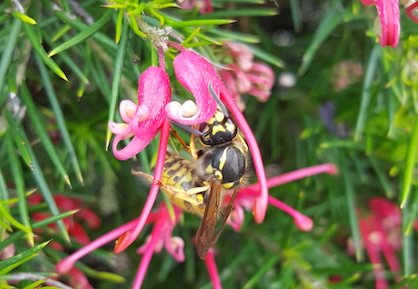2025
Journal - Research Article
Jandt, J. M., Barratt, B. I. P., Dickinson, K. J. M., McCombe, G. G. I., Tully, J., & Lord, J. M. (2025). The impact of floral diversity on bumblebee colony development and pollination efficacy among foragers. Apidologie, 56, 24. doi: 10.1007/s13592-025-01150-7
2024
Journal - Research Article
Ni, S., McCulloch, G. A., Kroos, G. C., King, T. M., Dutoit, L., Foster, B. J., Hema, K., Jandt, J. M., Peng, M., Dearden, P. K., & Waters, J. M. (2024). Human-driven evolution of color in a stonefly mimic. Science, 386(6270), 453-458. doi: 10.1126/science.ado5331
Jandt, J. M., McCall, E., & Toth, A. L. (2024). Native Polistes wasps (Hymenoptera: Vespidae) hold potential as biocontrol agents for lepidopteran pests of Brassica. Journal of Economic Entomology. Advance online publication. doi: 10.1093/jee/toae146
Grey, L., Holwell, G. I., Jandt, J. M., & Johnson, S. (2024). Weapon allometry and shape variation in the Helm's stag beetle (Geodorcus helmsi). Biological Journal of the Linnean Society. Advance online publication. doi: 10.1093/biolinnean/blae024
Conference Contribution - Published proceedings: Abstract
Busch, M. J., & Jandt, J. M. (2024). Behaviour and physiology of the common wasp, Vespula vulgaris. Proceedings of the 72nd Entomological Society of New Zealand (ESNZ) Conference. Retrieved from https://ento.org.nz/
McLean, C. E., McKinlay, P., & Jandt, J. M. (2024). BEE Creative: Participatory art + science. Proceedings of the 72nd Entomological Society of New Zealand (ESNZ) Conference. Retrieved from https://ento.org.nz/
Lau, O. L., McLean, C., & Jandt, J. (2024). Bee Aware Day 2023: A recipe for planning public science outreach. Proceedings of the 72nd Entomological Society of New Zealand (ESNZ) Conference. Retrieved from https://ento.org.nz/
2023
Journal - Research Article
Detoni, M., Johnson, S. L., Adams, C. I. M., Bengston, S., & Jandt, J. M. (2023). Older, but not wiser: Social wasp colony defensive behavior decreases with time, not experience. Insectes Sociaux, 70, 81-96. doi: 10.1007/s00040-022-00893-1
Journal - Research Other
Jandt, J. (2023). Insects and spiders make up more than half NZ's animal biodiversity: Time to celebrate these spineless creatures. The Conversation. Retrieved from https://theconversation.com/insects-and-spiders-make-up-more-than-half-nzs-animal-biodiversity-time-to-celebrate-these-spineless-creatures-195450
Conference Contribution - Published proceedings: Abstract
Thomas, L., Holwell, G. I., Jandt, J., & Johnson, S. (2023). Who wins in competitive interactions between males of the iconic New Zealand stag beetle, Geodorcus helmsi? Proceedings of the 71st Entomological Society of New Zealand (ESNZ) Conference. (pp. 44). Retrieved from https://ento.org.nz/
Jandt, J. M., McLean, C., & Evans, L. E. (2023). Pollinator performance and cognition in semi-natural simple or complex floral environments. Proceedings of the 71st Entomological Society of New Zealand (ESNZ) Conference. (pp. 34). Retrieved from https://ento.org.nz/
2022
Journal - Research Article
Chen, J. P. L., Dickinson, K. J. M., Barratt, B. I. P., & Jandt, J. M. (2022). Beetle (Coleoptera) communities inside and outside the pest-resistant fencing of a New Zealand ecosanctuary. New Zealand Entomologist, 45(1-2), 17-34. doi: 10.1080/00779962.2022.2120594
Neupert, S., Jandt, J. M., & Szyszka, P. (2022). Sugar alcohols have the potential as bee-safe baits for the common wasp. Pest Management Science, 78, 3005-3011. doi: 10.1002/ps.6925
Perry, B. J., Mohammadi Darestani, M., Ara, M. G., Hoste, A., Jandt, J. M., Dutoit, L., … Ingram, T., & Geoghegan, J. L. (2022). Viromes of freshwater fish with lacustrine and diadromous life histories differ in composition. Viruses, 14(2), 257. doi: 10.3390/v14020257
2020
Journal - Research Article
Jandt, J. M., Detoni, M., Loope, K. J., & Santoro, D. (2020). Vespula wasps show consistent differences in colony-level aggression over time and across contexts. Insectes Sociaux, 67(3), 367-381. doi: 10.1007/s00040-020-00768-3
Lamb, S. D., McCombe, G. G. I., Lawrence, E., Macwan, R., Mayer, T., & Jandt, J. M. (2020). Subterranean nesting behaviour in response to soil moisture conditions in the southern ant, Monomorium antarcticum Smith (Hymenoptera: Formicidae). New Zealand Entomologist, 43(1), 33-43. doi: 10.1080/00779962.2020.1764700
Iwasaki, J. M., Barratt, B. I. P., Jandt, J. M., Jowett, T. W. D., Lord, J. M., Mercer, A. R., & Dickinson, K. J. M. (2020). Honey bees do not displace foraging bumble bees on nectar-rich artificial flowers. Apidologie, 51, 137-146. doi: 10.1007/s13592-019-00690-z
2019
Journal - Research Article
Walton, A., Jandt, J. M., & Dornhaus, A. (2019). Guard bees are more likely to act as undertakers: Variation in corpse removal in the bumble bee Bombus impatiens. Insectes Sociaux, 66, 533-541. doi: 10.1007/s00040-019-00718-8
2018
Journal - Research Other
Miller, S. E., Bluher, S. E., Bell, E., Cini, A., Carvalho da Silva, R. C., Rodrigues de Souza, A., … Jandt, J., … Sheehan, M. J. (2018). WASPnest: A worldwide assessment of social Polistine nesting behavior [Data paper]. Ecology, 99(10), 2405. doi: 10.1002/ecy.2448
2017
Journal - Research Article
Jandt, J. M., Suryanarayanan, S., Hermanson, J. C., Jeanne, R. L., & Toth, A. L. (2017). Maternal and nourishment factors interact to influence offspring developmental trajectories in social wasps. Proceedings of the Royal Society B, 284(1857), 20170651. doi: 10.1098/rspb.2017.0651
2016
Journal - Research Article
Jandt, J. M., & Gordon, D. M. (2016). The behavioral ecology of variation in social insects. Current Opinion in Insect Science, 15, 40-44. doi: 10.1016/j.cois.2016.02.012
2015
Chapter in Book - Research
Jandt, J. M., & Toth, A. L. (2015). Physiological and genomic mechanisms of social organization in wasps (Family: Vespidae). In A. Zayed & C. F. Kent (Eds.), Advances in insect physiology (Vol. 48). (pp. 95-130). London, UK: Elsevier. doi: 10.1016/bs.aiip.2015.01.003
Journal - Research Article
Jandt, J. M., Thomson, J. L., Geffre, A. C., & Toth, A. L. (2015). Lab rearing environment perturbs social traits: A case study with Polistes wasps. Behavioral Ecology, 26(5), 1274-1284. doi: 10.1093/beheco/arv082
Sheehan, M. J., Botero, C. A., Hendry, T. A., Sedio, B. E., Jandt, J. M., Weiner, S., … Tibbetts, E. A. (2015). Different axes of environmental variation explain the presence vs. extent of cooperative nest founding associations in Polistes paper wasps. Ecology Letters, 18(10), 1057-1067. doi: 10.1111/ele.12488
McGlynn, T. P., Graham, R., Wilson, J., Emerson, J., Jandt, J. M., & Jahren, A. H. (2015). Distinct types of foragers in the ant Ectatomma ruidum: Typical foragers and furtive thieves. Animal Behaviour, 109, 243-247. doi: 10.1016/j.anbehav.2015.08.024
Jandt, J. M., Hunt, E. M., & McGlynn, T. P. (2015). Intraspecific food-robbing and neighborhood competition: Consequences for anti-robber vigilance and colony productivity. Biotropica, 47(4), 491-496. doi: 10.1111/btp.12234
2014
Journal - Research Article
Jandt, J. M., Tibbetts, E. A., & Toth, A. L. (2014). Polistes paper wasps: A model genus for the study of social dominance hierarchies. Insectes Sociaux, 61(1), 11-27. doi: 10.1007/s00040-013-0328-0
Jandt, J. M., Bengston, S., Pinter-Wollman, N., Pruitt, J. N., Raine, N. E., Dornhaus, A., & Sih, A. (2014). Behavioural syndromes and social insects: Personality at multiple levels. Biological Reviews, 89(1), 48-67. doi: 10.1111/brv.12042
Jandt, J. M., & Dornhaus, A. (2014). Bumblebee response thresholds and body size: Does worker diversity increase colony performance? Animal Behaviour, 87, 97-106. doi: 10.1016/j.anbehav.2013.10.017
Bengston, S. E., & Jandt, J. M. (2014). The development of collective personality: The ontogenetic drivers of behavioral variation across groups. Frontiers in Ecology & Evolution, 2, 81. doi: 10.3389/fevo.2014.00081
Conference Contribution - Published proceedings: Abstract
Jandt, J., Jeanne, R., Hermanson, J., & Toth, A. (2014). Epigenetic maternal effects on caste development in Polistes wasps. Proceedings of the International Union for the Study of Social Insects International Congress. (pp. 57). Retrieved from http://www.iussi.org/
Jandt, J., & Toth, A. (2014). The effects of rearing environment on physiological development of Polistes wasps. Proceedings of the International Union for the Study of Social Insects International Congress. (pp. 211). Retrieved from http://www.iussi.org/
2013
Journal - Research Article
Jandt, J., Larson, H. K., Tellez, P., & McGlynn, T. P. (2013). To drink or grasp? How bullet ants (Paraponera clavata) differentiate between sugars and proteins in liquids. Naturwissenschaften, 100(12), 1109-1114. doi: 10.1007/s00114-013-1109-3
2012
Journal - Research Article
Jandt, J. M., Robins, N. S., Moore, R. E., & Dornhaus, A. (2012). Individual bumblebees vary in response to disturbance: A test of the defensive reserve hypothesis. Insectes Sociaux, 59(3), 313-321. doi: 10.1007/s00040-012-0222-1
2011
Journal - Research Article
Couvillon, M. J., Jandt, J. M., Bonds, J., Helm, B. R., & Dornhaus, A. (2011). Percent lipid is associated with body size but not task in the bumble bee Bombus impatiens. Journal of Comparative Physiology A, 197(11), 1097-1104. doi: 10.1007/s00359-011-0670-5
Jandt, J. M., & Dornhaus, A. (2011). Competition and cooperation: Bumblebee spatial organization and division of labor may affect worker reproduction late in life. Behavioral Ecology & Sociobiology, 65(12), 2341-2349. doi: 10.1007/s00265-011-1244-9
Journal - Research Other
Bengston, S. E., Jandt, J., & Dornhaus, A. (2011). [Review of the book Food exploitation by social insects: Ecological, behavioral, and theoretical approaches]. Quarterly Review of Biology, 86(4), 359.
2010
Journal - Research Article
Couvillon, M. J., Jandt, J. M., Duong, N., & Dornhaus, A. (2010). Ontogeny of worker body size distribution in bumble bee (Bombus impatiens) colonies. Ecological Entomology, 35(4), 424-435. doi: 10.1111/j.1365-2311.2010.01198.x
Jandt, J. M., Taylor, B., & Jeanne, R. L. (2010). Temperature and forager body size affect carbohydrate collection in German yellowjackets, Vespula germanica (Hymenoptera, Vespidae). Insectes Sociaux, 57(3), 275-283. doi: 10.1007/s00040-010-0082-5
Awarded Doctoral Degree
Jandt, J. M. (2010). Mechanisms of organization in social insects: The influences of spatial allocation, dominance interactions, and worker variation in bumble bees (PhD). University of Arizona. Retrieved from http://hdl.handle.net/10150/193522
2009
Journal - Research Article
Jandt, J. M., & Dornhaus, A. (2009). Spatial organization and division of labour in the bumblebee Bombus impatiens. Animal Behaviour, 77(3), 641-651. doi: 10.1016/j.anbehav.2008.11.019
Jandt, J. M., Huang, E., & Dornhaus, A. (2009). Weak specialization of workers inside a bumble bee (Bombus impatiens) nest. Behavioral Ecology & Sociobiology, 63(12), 1829-1836. doi: 10.1007/s00265-009-0810-x
2007
Conference Contribution - Published proceedings: Abstract
Jandt, J. M. (2007). In-nest task specialization in the bumble bee Bombus impatiens. Proceedings of the Entomological Society of America (ESA) Annual Meeting. Retrieved from https://esa.confex.com/esa/2007/techprogram/paper_29735.htm
2005
Journal - Research Article
Jandt, J. M., Curry, C., Hemaur, S., & Jeanne, R. L. (2005). The accumulation of a chemical cue: Nest-entrance trail in the German yellowjacket, Vespula germanica. Naturwissenschaften, 92(5), 242-245. doi: 10.1007/s00114-005-0613-5
Jandt, J. M., & Jeanne, R. L. (2005). German yellowjacket (Vespula germanica) foragers use odors inside the nest to find carbohydrate food sources. Ethology, 111(7), 641-651. doi: 10.1111/j.1439-0310.2005.01088.x
Jandt, J. M., Riel, L., Crain, B., & Jeanne, R. L. (2005). Vespula germanica foragers do not scent-mark carbohydrate food sites. Journal of Insect Behavior, 18(1), 19-31. doi: 10.1007/s10905-005-9344-x

